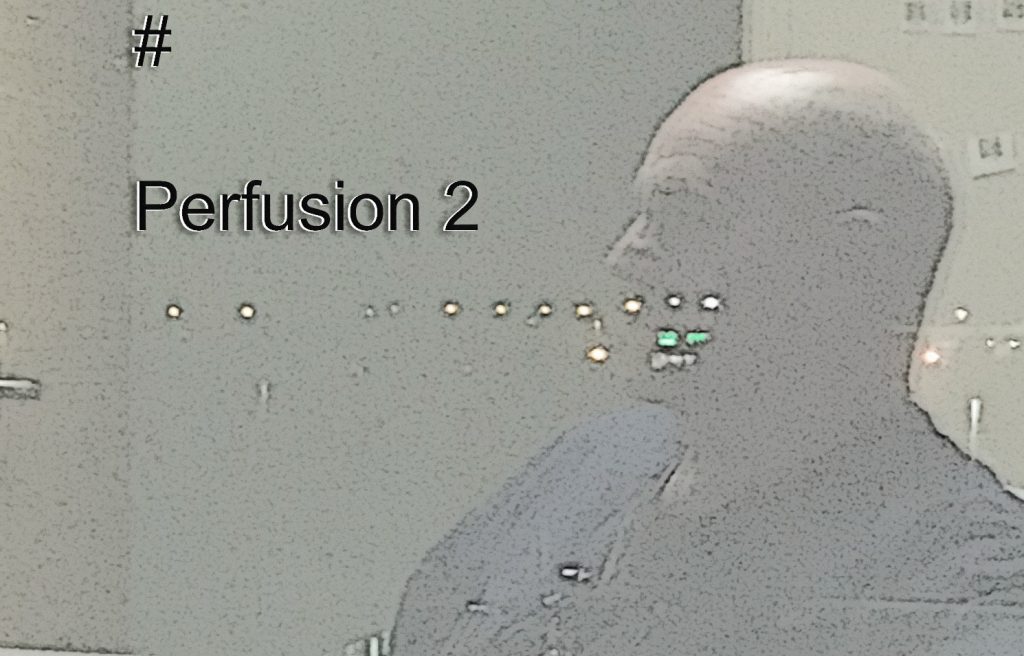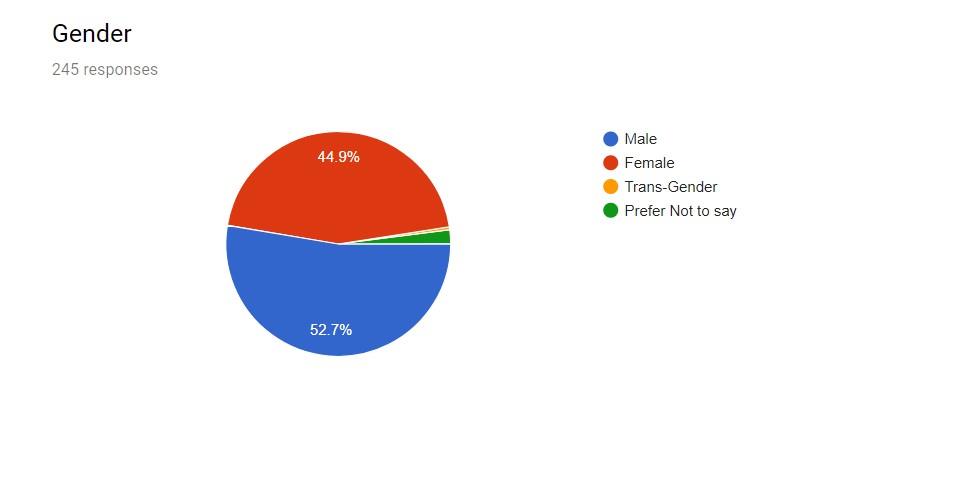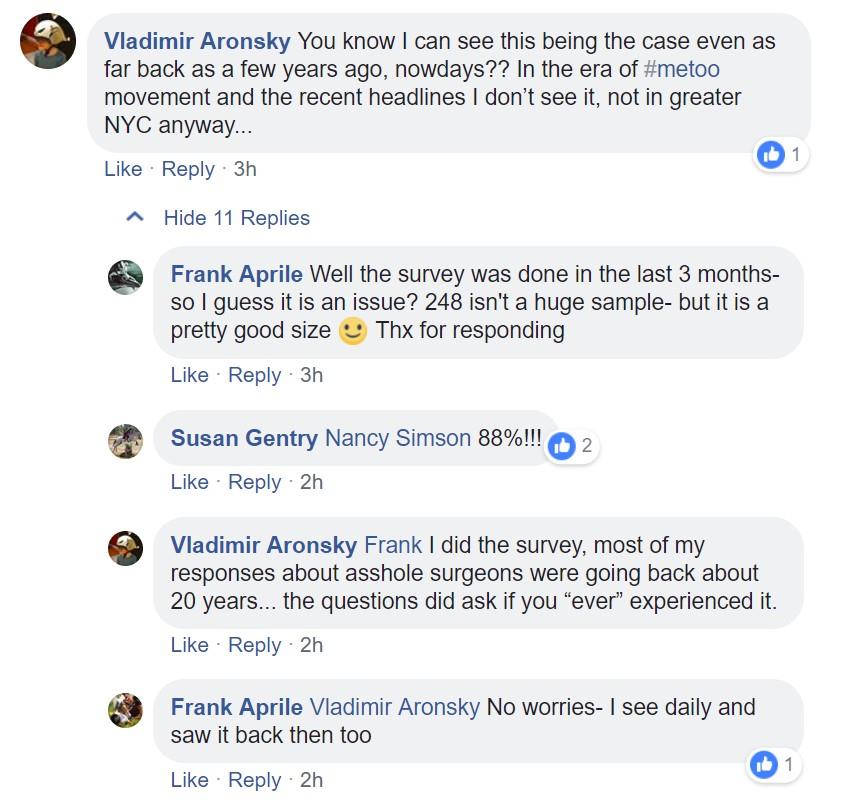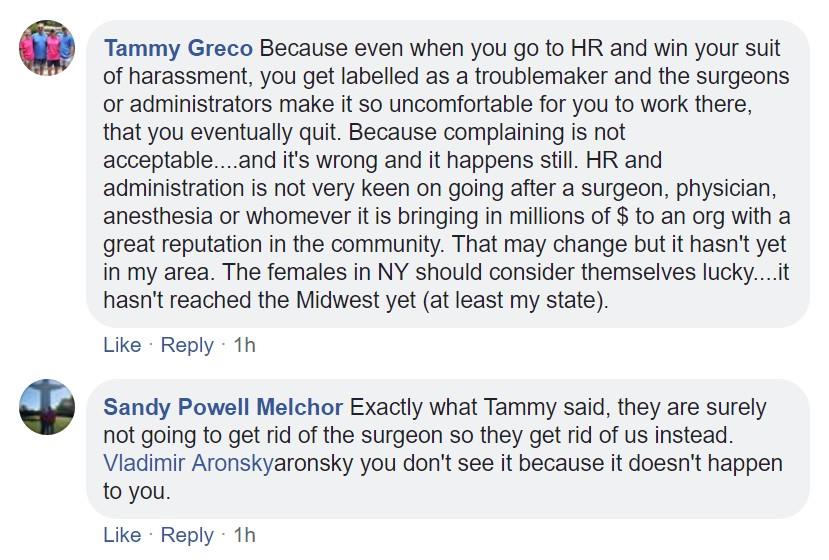88% of Female Respondents Claim a Hostile Work Environment in the CV Surgery Arena! # Perfusion2 Survey Results

“Essentially, what the female candidate entering this specialized field of medicine needs to reckon with is that almost 9 out of 10 of them will experience some sort of harassment or hostility in their workplace…”
YEP- That Pretty Much Sums it Up…
Editor’s Note:
Over the past few months, putting this survey together and constantly poking and prodding on social media to suggest participation- had certainly made me think whether or not “it was over the top” or “overly sensitive”- or a “grow a pair” (which is in-and-of-itself completely misogynistic) – and it certainly made me question myself- my motivations- and “what was the point”?
What got me there was the fact that I was planning on addressing this issue in an upcoming book I am publishing on perfusion life-
YEAH- We Have a Problem…
Click HERE to View Entire Series #Perfusion2
When I thought about doing this survey, it was as a culmination of observations /experiences gleaned from a body of work encompassing the following: Providing perfusion services to 52 hospitals here in the United States and Canada, working as a Surgical 1st Assistant at another 7-10 hospitals, serving as a US Navy Hospital Corpsman attached to USMC for 4.8 years, and working as a Hospital Janitor for 2 years while in High School. This represents 45 years of on the job- first hand exposure to the politics and social dynamics of medical personalities and interactions.
There is an inherent risk of being labeled as a “trouble maker”, of “rocking the boat” so to speak- when coming out with serious and disturbing observations regarding workplace malice and discord. A lot of people don’t want to deal with it, face it, or acknowledge that they themselves are either on the delivering end of the spectrum- or the receiving end. Neither one of the the extremes is a desirable place anyone wants to be labeled to, nevertheless, it is those of us mired in the haze and muck of the middle ground (in terms of exposure to abuse) that must recognize what is going on around us, and articulate it with some sort of action that goes beyond, “oh that’s just the doctor having a bad day”, “things will never change regardless of what we do”.
Victims of prolonged abuse are susceptible to a Stolkholm Syndrome of sorts:
“Stockholm syndrome can be seen as a form of traumatic bonding, which does not necessarily require a hostage scenario, but which describes “strong emotional ties that develop between two persons where one person intermittently harasses, beats, threatens, abuses, or intimidates the other.”[1] One commonly used hypothesis to explain the effect of Stockholm syndrome is based on Freudian theory. It suggests that the bonding is the individual’s response to trauma in becoming a victim. Identifying with the aggressor is one way that the ego defends itself. When a victim believes the same values as the aggressor, they cease to be a threat…”
I have witnessed this countless times, as subordinate staff align themselves with an abusive surgeon- effectively throwing the “victim of the day” under the bus- thus avoiding becoming the target themselves. It is despicable yet very human- but it sickens me to watch.
Perspective: (Setting the Baseline)
A 2015 RAND Study Gives Us A Baseline for comparison:
Courtesy of THE MARKETPLACE ( https://www.marketplace.org/2017/08/16/business/one-five-us-workers-are-exposed-hostile-work-environment)
From July to October 2015, RAND surveyed more than 3,000 people for its American Working Conditions Survey that was released last week. It found that almost 20 percent of U.S. workers are exposed to a hostile work environment.
“Nearly one in five American workers were subjected to some form of verbal abuse, unwanted sexual attention, threats, or humiliating behavior at work in the past month or to physical violence, bullying or harassment, or sexual harassment at work in the past 12 months,” according to the report. “Among men, the most common adverse events were verbal abuse and threats (13 percent in the past month), humiliating behavior (10 percent in the past month), bullying or harassment (9 percent in the past year), physical violence (2 percent in the past year), and unwanted sexual attention (1 percent in the past month). Among women, the most common adverse events were verbal abuse and threats (12.1 percent in the past month), bullying or harassment (11 percent in the past year), humiliating behavior (8 percent in the past month), unwanted sexual attention (5 percent in the past month), and physical violence (1 percent in the past year).”
The data collected by RAND revealed a series of trends. For example, college graduates were less likely to experience abuse in the workplace. Workers who frequently interact with customers or clients were more likely to experience abuse or harassment. Younger workers were more likely to be targeted for abuse — with younger men being more likely to experience verbal abuse and younger women being more likely to experience unwanted sexual attention.
We will use this model as a baseline as a point of reference when comparing the results in the cardiovascular field to those of workers in the business sector.
Tools & Methods
Objective:
- Identify and describe the types of harassment encountered in the Operating Room and the CV profession.
- Isolate responses based on the demographic variables of the respondent pool.
Method:
A google form survey was developed to allow anonymous users the ability to answer a range of questions regarding abuse in the operating rooms at their institution. This form was delivered and offered via social media platforms that are specific to the Cardiovascular arena. A thorough review of submitted forms was done to ensure that entries were not repetitive and that users did not duplicate responses.
N=248. The goal was to get a sample size large enough to make the results credible, the analysis is limited to 248 respondents with the survey remaining open for continued harvesting of data.
Summary graphics were rendered by Google Docs, and hard data was automatically exported to a Google Docs spreadsheet- which was then exported to the MS Excel spreadsheet platform. Analysis and data results were synthesized using Excel Pivot Tables to render a rather simple extrapolation of data relationships as will be discussed below. No statistical analysis was attempted or performed.
Data Collection:
- Stratify and categorize the types of harassment by:
- Gender
- Age
- Marital Status
- Culture/Geo-political
- Sexual Orientation
- Appearance (self assessment)
- Professional Status
- Area of Practice
- Level of Experience in Medicine
- Categorize the Source of Abuse
- MD
- Peer
- Management
- Administration
- Employer
- Categorize the Type of Abuse
- Verbal
- Physical
- Sexual
- Emotional
- Intellectual
- Categorize the Onset and Duration of Abuse
- Onset
- Duration
- Categorize the Reaction to the Abuse
- Physical
- Emotional
- Categorize the Impact of the Abuse
- Self-blame and feelings of shame and guilt Fear, terror, and feeling unsafe
- Anger and rage
- Anger turned inward, depression, and suicidal feelings
- Substance abuse
- Eating disorders
- Physical symptoms
- Self-harm
- Grief and loss
- Loss of control, powerlessness
- Changes in sexuality and intimacy
- Categorize the Measures Taken to Stop the Abuse
- Confrontation
- Administrative
- Change of Employer/Employment
- Evaluation of the Effectiveness of Steps Taken to Stop the Abuse
- Discipline versus Termination Versus Counseling
- Subjective assessment of whether or not change is or isn’t possible
- Outcome of Intervention(s) Taken:
- Effectiveness
- Success/Failure to Change Behavior
Results & Graphs
Discussion:
BIAS:
The implied bias in this survey would be to assume that there would be more Female respondents as opposed to Male respondents.
Results Interpretation:
The results speak for themselves. Almost 53% of respondents are male as opposed to 45% female.
Discussion:
BIAS:
The implied bias in this survey would be to assume that there would be more “Females claiming Yes I have been harassed”– then “No I haven’t been harassed”– responses.
As it stands:
- 126/181 People (or 69.6% state they have been subjected to a hostile work environment)
- 75/85 Females (or 88.2% state they have been subjected to a hostile work environment)
- 51/96 Males (or 53.1% state they have been subjected to a hostile work environment)
Results Interpretation:
The results speak for themselves. It is no surprise that Females outpace Males in their experience of some sort of harassment or hostility in the CV Surgical work environment. As it stands Males (at 53%- experience harassment at 2.5 times the rate of their counterparts from the Business sector based on the RAND study, but the staggering reality that stands before us is the 88% Harassment rate for females entering the CV surgery working sector. This represents an almost 450% higher rate of harassment (4.5 times the rate reported for the Business Sector as detailed by the RAND study).
Essentially, what the female candidate entering this specialized field of medicine needs to reckon with is that almost 9 out of 10 of them will experience some sort of harassment or hostility in their workplace…
To Follow:
Part 3: Quantifying the TYPES of Verbal, Sexual, and Intellectual Abuse victims encounter when Identifying Hostility in the CV Work Environment
Social Media Comments










